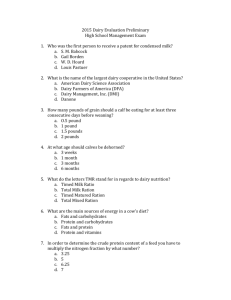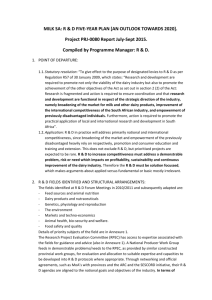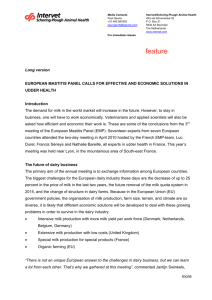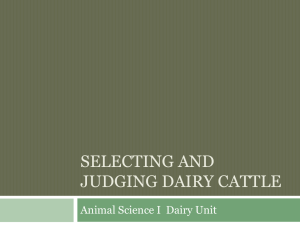MSA Memo to RPEC_R & D Progr to 2020 (2)
advertisement
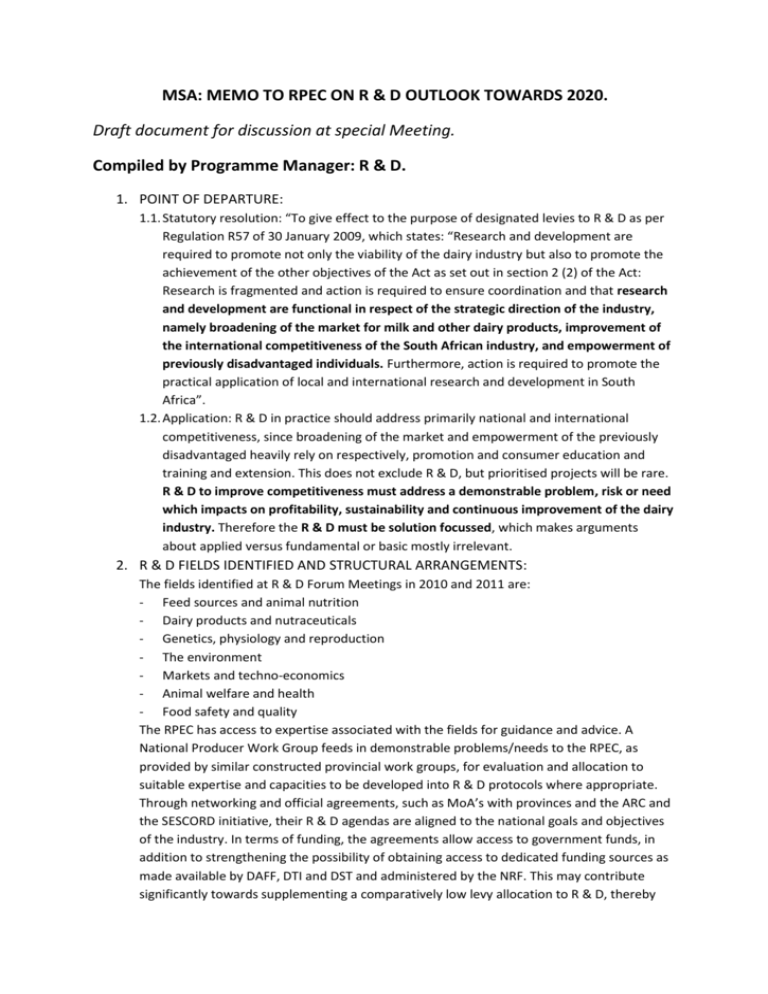
MSA: MEMO TO RPEC ON R & D OUTLOOK TOWARDS 2020. Draft document for discussion at special Meeting. Compiled by Programme Manager: R & D. 1. POINT OF DEPARTURE: 1.1. Statutory resolution: “To give effect to the purpose of designated levies to R & D as per Regulation R57 of 30 January 2009, which states: “Research and development are required to promote not only the viability of the dairy industry but also to promote the achievement of the other objectives of the Act as set out in section 2 (2) of the Act: Research is fragmented and action is required to ensure coordination and that research and development are functional in respect of the strategic direction of the industry, namely broadening of the market for milk and other dairy products, improvement of the international competitiveness of the South African industry, and empowerment of previously disadvantaged individuals. Furthermore, action is required to promote the practical application of local and international research and development in South Africa”. 1.2. Application: R & D in practice should address primarily national and international competitiveness, since broadening of the market and empowerment of the previously disadvantaged heavily rely on respectively, promotion and consumer education and training and extension. This does not exclude R & D, but prioritised projects will be rare. R & D to improve competitiveness must address a demonstrable problem, risk or need which impacts on profitability, sustainability and continuous improvement of the dairy industry. Therefore the R & D must be solution focussed, which makes arguments about applied versus fundamental or basic mostly irrelevant. 2. R & D FIELDS IDENTIFIED AND STRUCTURAL ARRANGEMENTS: The fields identified at R & D Forum Meetings in 2010 and 2011 are: - Feed sources and animal nutrition - Dairy products and nutraceuticals - Genetics, physiology and reproduction - The environment - Markets and techno-economics - Animal welfare and health - Food safety and quality The RPEC has access to expertise associated with the fields for guidance and advice. A National Producer Work Group feeds in demonstrable problems/needs to the RPEC, as provided by similar constructed provincial work groups, for evaluation and allocation to suitable expertise and capacities to be developed into R & D protocols where appropriate. Through networking and official agreements, such as MoA’s with provinces and the ARC and the SESCORD initiative, their R & D agendas are aligned to the national goals and objectives of the industry. In terms of funding, the agreements allow access to government funds, in addition to strengthening the possibility of obtaining access to dedicated funding sources as made available by DAFF, DTI and DST and administered by the NRF. This may contribute significantly towards supplementing a comparatively low levy allocation to R & D, thereby supporting a sustainable R & D programme. The network requires continuous strengthening towards 2020 to ensure effective service to the industry. 3. R & D FIELDS SERVICED BY CURRENT PROJECTS: 3.1. Animal welfare and health: 3.1.1. Fasciolosis (liver fluke) – Project by UP (Onderstepoort) started in 2015 and is envisaged to be completed in 2017. Title: Fasciola hepatica: Impact on dairy production and sustainable management on selected farms in South Africa. Project leader: Dr Jan van Wyk, BVSc. Total budget: R967 626 (2015 – R701 183; 2016 – R266 443) Objectives in brief: Investigation of prevalence, seasonal cycling, mode of transmission of the parasite and management programs followed by farmers, and in addition, anthelmintic efficacy. Comment: Project continuation/direction in second year will depend on results obtained in first year. 3.1.2. Mastitis 3.1.2.1. Project by UP (Onderstepoort) started in 2015 and is envisaged to be completed in 2018. Title: Resistance to available antibiotics in lactating cows with mastitis. Project leader: Dr Martin van der Leek, BVSc, MS Total budget: R1 391 500 (2015 – R514 616; 2016 – R561 184; 2017 – R315 700). Objectives in brief: Characterization and prevalence of mastitis-causing organisms, testing in vitro sensitivity of the organisms, establishing antibiotic resistance and observing mastitis management programs on farms. Comment: Project continuation/direction in subsequent years will depend on results obtained in first year. 3.1.2.2. Project by UKZN (Plant Pathology) started in 2013; involvement by Milk SA from 2015 and is envisaged to be completed in 2018. Title: Investigating alternative methods such as bacteriophages and bacteriocins to control mastitis organisms. Project leader: Prof Mike Laing, PhD Total budget: R2 352 891 (2015 – R771 294; 2016 – R761 355; 2017 – R 820 242). Objectives in brief: Classify and determine efficacy of bacteriophages against Staphylococcus aureus; isolate bacteriocins from Staphylococcal and Streptococcal strains; do in vitro screening and efficacy tests; test promising isolates in vivo; develop commercial products. Comments: Promising bacteriophage isolates were identified in a PhD study (Dr Iona Basdew) in 2013. These are further challenged and quality control done in 2015; other possibilities are investigated to develop a mix to facilitate non-adaptation by mastitis pathogens. 3.1.3. Disease monitoring – Project by Veterinary Network (V-Net), started in 2014 and is open-ended. Title: National disease monitoring and extension system for the Dairy Industry. Project leader: Dr Danie Odendaal, BVSc Total budget: R178 500 for 2015 Objectives in brief: Outbreaks and general occurrence of diseases are monitored throughout the country with the aid of some 120 private veterinarians; a report programme is developed to facilitate timely report and reaction; application to cell phone is investigated. Comments: Success and application methodology are evaluated every year to determine continuation, efficacy and development of adapted or new methodology. 3.2. Food safety and quality Microbial contamination of milk – Project by UP (Main Campus), started in 2013 and completed in 2015. Title: Characterization of coliform bacteria and Escherichia coli from fresh milk to determine the prevalence of possible pathogenic types. Project leader: Prof Elna Buys, PhD. Total budget: R100 000. Objectives in brief: Characterization of colifoms; pathogenic and commensal E.coli for relatedness of strains from various strains, their virulence and antibiotic resistance. Comments: The project is in the final stages; there remains an objective of stochastic modelling, but this will be determined by requirements of the Dairy Standards Agency which initially expressed the need for the project. 4. PROJECTS SUPPORTED WITH NO FINANCIAL OBLIGATIONS: 4.1. Döhne, Eastern Cape – Once-a-day-milking, as model for developing farmers and Livestock Development Project 4.2. Elsenburg and other stations, Western Cape – Silage potential of small grains, legumes and within intercropping systems for milk production. 4.3. Fort Hare – Animal welfare studies at Amadlelo facilities. 4.4. Fort Hare/Döhne – Benchmark project for milk production for developing Farmers in the Eastern Cape. 4.5. Studbook – Project to analyse data of farmer Conrad Dreyer in the Eastern Cape that does crossing with Nordic breeds on the assumption that this may reduce mastitis. 4.6. Other – Inventory of R & D projects done in SA [will be available in July 2015). 5. R & D DISCIPLINES/PROGRAMMES ENVISAGED TOWARDS 2020: 5.1. R & D Field: Feed sources and animal nutrition, plus Food safety and quality: 5.1.1. Milk flocculation: 5.1.1.1. The effect of cow nutrition on milk flocculation 5.1.1.2. The significance of proteolytic psyghrotrophs as a cause of milk flocculation/protein instability 5.1.1.3. The impact of proteases and chemicals on milk flocculation Comments: The programme has already been accepted; anticipated date of commencement is 2016; projects 5.1.1.2 and 5.1.1.3 may be consolidated as they may portray sequential events in the milk collection line. 5.2. R & D Field: Genetics, Physiology and Reproduction: 5.2.1. Genetic and performance monitoring: Nature of project: Statistical trend monitoring of participating farmer results over time to establish progress of critical indicators. Anticipated date: 2016, open-ended. 5.2.2. Selection based on Residual Feed Intake: Motivation: Using this method, heifers within large herds can be selected on growth rate that will carry through to milk production. This will reduce rearing cost and identify efficient replacements. Additional merit is RFI is repeatable on different diets, it is robust, cows with lower intake have lower GHG emissions and they show improved immunity. See Annexure 3 attached. Nature of project: Demonstrations and monitoring on farm. Anticipated date: 2016, open-ended. 5.3. R & D Field: Animal welfare and health: 5.3.1.1. Programme: Biological control of Fasciola and nematodes 5.3.1.2. Project proposal: UKZN (Plant Pathology) Project leader: Prof Mark Laing, PhD Project title: Integrated control of Fasciolosis of livestock. Budget: R300 000 per year for 3 years. Comments: Application to Research & Technology Fund (RTF) of the DAFF at NRF; commencement date 2016; funding specifications indicate a 4:1 ratio between RTF and industry partner (Milk SA). 6. PROPOSALS TOWARDS 2020: 6.1. R & D Field: Animal welfare and health: 6.1.1. Mastitis: The disease should be addressed from different angles. 6.1.1.1. From the results of item 3.1.2.1. the pathogens dominant in specific areas should be known. This may allow R & D associated with vaccine development, either through local testing of imported vaccines or through own R & D. Possible R & D project leader: Dr Inge-Marie Petzer, UP (Onderstepoort). [Comment: She found promising results with the vaccine Startvac]. 6.1.1.2. Genetic progress against the disease may be obtained through crossbreeding (see Annexure 6), or preferably within breed using genomic/SNP analysis. The preliminary statistical analysis of the data of farmer Conrad Dreyer (item 4.5) may provide directives. Possible R & D project leader: Dr Japie van der Westhuizen, SA Studbook or Prof Esté van Marle-Köster, UP (or ARC, Irene). 6.1.2. National Disease Monitoring and Extension Programme: A value-adding development could be development of rapid on-site diagnostic tools. Such equipment and identification methodology (e.g. for FMD and RVF) have been developed by Bio-Sciences of the CSIR in association with Australia’s CSIRO. This should be further investigated. Possible R & D project leader: Dr Phiyani Lebea, CSIR. 6.1.3. Lameness: The condition is one of the most devastating and costly which is not well-recognized by farmers. Farmers may lose up to one-third of the milk yield of an affected cow. It is also a serious animal welfare issue and therefore the Dairy Industry should be seen to do work in this area, even though there are many programs elsewhere in the world. Possible R & D project leader: Prof Voster Munchenje, Fort Hare. Furthermore, Cheminique in association with the Zinpro Corporation is on the forefront of lameness extension and assists with R & D. Ms Jackie Tucker of the company is interested to do a PhD on SA work and May consider Prof Lourens Erasmus of UP as supervisor. 6.2. R & D Field: Environment: 6.2.1. Pasture establishment in the south-eastern seaboard: Substitution of virgin forest with monoculture pasture species has implications for bio-diversity, ecosystems, eutrophication and water sources. Heavy fertilization and cattle manure may also cause pollution. Outeniqua Research Station has an R & D and monitoring programme with programme leader Dr Pieter Swanepoel. He has since joined the US. It is important that this programme continue and it should be promoted through the SESCORD initiative, amongst others to encourage Dr Swanepoel to remain involved. 6.2.2. Carbon and water footprint: Although figures and knowledge are mostly available, DEA is required to report regularly to the IPCC on mitigation, which requires updated figures. The envisaged government pressure which may lead to taxation could require actual measurements to demonstrate decreasing trends. This may also require an inventory and documentation. 6.3. R & D Field: Feed sources and animal nutrition: 6.3.1. Pasture cultivar testing/selection: The ARC facility at Cedara is expected to be revived and programmes resumed. Outeniqua is expected to continue. SESCORD should provide guidance. 6.3.2. Concentrate supplementation: Supplements are expensive and the inclusion of feed sources that could improve cost effectiveness must be encouraged, also to combat the continuous burden of sub-clinical acidosis (both in TMR and pasture-based systems). There are a number of potential project leaders that can be approached, depending on system and locality.


